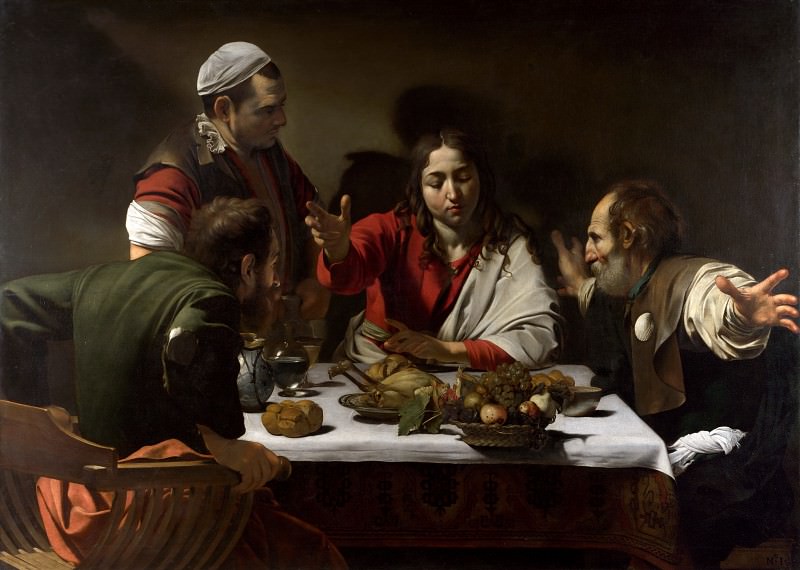The Supper at Emmaus Michelangelo Merisi da Caravaggio (1571-1610)
Michelangelo Merisi da Caravaggio – The Supper at Emmaus
Edit attribution
Download full size: 5929×4223 px (5,0 Mb)
Painter: Michelangelo Merisi da Caravaggio
The painter Caravaggio painted between 1599 and 1606 two paintings on the same Gospel subject - after the resurrection, Jesus appears to the two disciples. Cleopas and another man, whose name is unknown, were on their way from Jerusalem to Emmaus after the execution of Christ’s teacher. On their way the disciples encountered a mysterious wayfarer, who talked to them about the recent and sensational events.
Description of Michelangelo Merisi da Caravaggio’s Dinner at Emmaus
The painter Caravaggio painted between 1599 and 1606 two paintings on the same Gospel subject - after the resurrection, Jesus appears to the two disciples. Cleopas and another man, whose name is unknown, were on their way from Jerusalem to Emmaus after the execution of Christ’s teacher.
On their way the disciples encountered a mysterious wayfarer, who talked to them about the recent and sensational events. It was gradually getting darker, so they invited their new friend to stay with them in the inn until the following day.
The artist’s canvas depicts a moment of dinner at the inn, and more specifically, a second of the apostles recognizing in the fellow traveler their dead mentor, the Son of God. The men recognized Jesus by the symbolic gesture of blessing food with their hands. Cleopas (who was sitting with his back to the onlooker) suddenly stirred up strong emotions-a mixture of surprise, consternation, and joy-grabbed the handles of his seat and stood up from his seat. A second follower of Christ spread his arms to his sides in rapture. The third character, the master of the house, sees nothing supernatural as he does not understand the conversation of his guests.
Everything in the painting is permeated with profound symbolism. The cooked game on the white tablecloth and the dark fruits of grapes are a sign of death. White grapes and pomegranates are positive symbols of life and resurrection. The apple is a reminder of the sin of the first people and its redemption by the coming Messiah. The bread and wine are Eucharistic objects. The seashell on the disciple’s garment is a symbol of the pilgrim.
The uniqueness of the image is in the non-iconic image of Christ: a face without a beard and full-bodied. Otherwise, the painter tried to make the subject realistic by artistic means, so that the viewer feels himself a participant of this dinner and a divine phenomenon. The connoisseurs of Caravaggio’s work admit that the master succeeded in his plan.
Кому понравилось
Пожалуйста, подождите
На эту операцию может потребоваться несколько секунд.
Информация появится в новом окне,
если открытие новых окон не запрещено в настройках вашего браузера.
You need to login
Для работы с коллекциями – пожалуйста, войдите в аккаунт (open in new window).


















COMMENTS: 2 Ответы
Этот "Ужин... " совсем не тот. Другая картина с тем же названием намного лучше во всех отношениях.
Это полотно отличается драматичностью освещения, театральностью жестов и высочайшим реализмом в передаче деталей.
Картина несет на себе самые характерные черты "фирменного" стиля Караваджо – фигуры помещены здесь в закрытом пространстве, на фоне плоского задника, фиксирующего резкие тени. Свет на картине падает сверху слева, образуя подобие нимба, окружающего голову Христа. На столе мы видим жареную птицу, хлеб, вино, воду и фрукты. Детали, изображенные в реалистической манере, являются вместе стем очевидными символами. Хлеб и вино здесь символизируют Причастие; жареная птица и переспелые фрукты – смерть; гранат – Воскресение
(гранат обычно связывается с мифологической Персефоной, полгода проводившей в Царстве мертвых, но воскресавшей с наступлением весны).
Использование светотени в картине " Ужин в Эммаусе" является поворотным пунктом в истории живописи.
You cannot comment Why?
This painting depicts the biblical scene of The Supper at Emmaus. Four men are gathered around a table laden with food, including a roast chicken, bread, and fruit. The central figure, a young man with long hair, is dressed in a red tunic and a white cloth draped over his shoulder. He is in the act of breaking bread or making a gesture with his hand.
To his left, a man in a green tunic is leaning forward, appearing to be in deep thought or perhaps in awe. To his right, an older man with a grey beard and expressive hands is gesturing animatedly, his mouth open as if speaking. Behind the central figure stands another man, also with a distinctive head covering, observing the scene.
The lighting in the painting is dramatic, with a strong source of light illuminating the figures and the table, casting deep shadows in the background. This use of chiaroscuro emphasizes the emotional intensity of the moment.
Subtexts:
The painting captures the moment of recognition when the disciples of Jesus, Cleopas and another unnamed disciple, realize they are in the presence of the resurrected Christ on the road to Emmaus. The act of blessing and breaking bread is a direct reference to the Last Supper and the Eucharist. The disciples and the innkeepers reactions – disbelief, astonishment, and realization – are central to the narrative. The painting, therefore, explores themes of faith, revelation, the divine presence, and the transformative power of recognizing the sacred in the ordinary. The stark realism and dramatic lighting, characteristic of Caravaggios style, serve to heighten the emotional and spiritual impact of the event, making the divine encounter feel immediate and tangible.